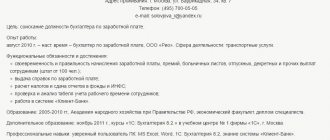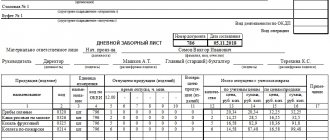Based on the Labor Code, in addition to the basic salary, the employer has the right to pay its employees other payments that are compensatory and incentive in nature. Such payments are distributed among employees in accordance with their fulfillment of certain performance criteria. Information about the fulfillment of these criteria is entered into the evaluation sheet for incentive payments. In the article we will look at what a score sheet is and how incentive payments are calculated based on it.
What are the incentive payments?
One of the important ways to stimulate company employees is their bonuses. The appointment of such payments in a company is possible on one of the following grounds:
- continuous work experience in one company, length of service;
- labor productivity;
- intensity of work activity, as well as achievements at work;
- for the quality of the work performed.
An indicator such as continuous work experience is quantitative and can be calculated without difficulty. Other indicators are qualitative and must be assessed according to certain criteria. Such criteria are enshrined in regulations in accordance with the sector of activity of the organization (for example, the field of education, culture and medicine). That is, in this case we mean budgetary organizations. Based on these documents, the budgetary organization develops local regulations that contain criteria for determining the labor efficiency of employees, as well as linking these indicators to incentive payments (
Employee evaluation sheet based on rotation results
Employee RATING SHEET based on rotation results
————————————————————————— ¦ Competencies ¦ Achieved result ¦ +————————————+————— ———————+ ¦ A ¦ ¦ +————————————+————————————+ ¦ B ¦ ¦ +—————— ——————+————————————+ ¦ C ¦ ¦ +————————————+———————————— + ¦ D ¦ ¦ +————————————+————————————+ ¦ E ¦ ¦ ————————————-+ ————————————- (A): Exceptional results in ongoing work, requires little or no supervision.
(B): Achieved goals to a greater extent than expected, very good performance in a number of areas, supervision required occasionally.
(C): Achieved results and contributed as expected, routine supervision required.
(D): Partially meets performance criteria; performance improvement is required.
(E): Performance is unsatisfactory for this position and requires immediate, significant improvement.
Customer focus 1 1 2 3 1. Independently analyzes information received from — — — the client, critically evaluates the results of the work done, — — — reports the results to management. 2. Seeks to obtain information about how the client — — — evaluates the quality of the company’s services, as well as what — — — is necessary to improve this rating. Actively contributes to these improvements in company practices. 3. When working with a client, he constantly tries to strengthen — — — the positive image of the company. — — — 4. Tries to create, maintain and strengthen — — — relationships with the client’s personnel. — — — 5. Able to retrieve and report — — — significant customer information in a timely manner. Is a good — — — listener. 6. Complies with the rules for working with confidential — — — information — — — Result: — — — — — —
1 Note: The rating is given on a 3-point scale: 1 - the lowest, 3 - the highest, 2 - mediocre.
A comment:
_______________________________________________________________________ _______________________________________________________________________ Management skills 1 2 3 7. Good interaction has been established with other members of the — — — team; The employee demonstrates an excellent understanding of his — — — work role and tasks within the group. 8. Tries to exceed management’s expectations in work results. — — — 9. Able to cope well with stressful situations and — — — demonstrates the ability not to reduce the quality of work in — — — time-poor conditions. 10. Demonstrates the ability to distribute work and - - - responsibility between subordinates. — — — 11. Has the ability to cope with the assigned — — — task independently. — — — Result: — — — — — — Comment: _________________________________________________________________________ _________________________________________________________________________ Level of professional training 1 2 3 12. Demonstrates an excellent level of general professional — — — preparation. — — — 13. Finishes work on time. — — — — — — 14. Well understands and is able to list his — — — functional responsibilities. — — — 15. Able to independently prepare working — — — materials, analyze them and correctly present conclusions. — — — 16. Able to make constructive suggestions to — — — improve clients’ business. — — — 17. Able to implement the “managerial chain”: — — — analyze the situation, plan actions, provide — — — control, get results. Result: — — — — — — Comment: _______________________________________________________________________ _______________________________________________________________________ Self-improvement skills 1 2 3 18. Manages his own time effectively. — — — — — — 19. Continues to improve and develop — — — communication skills. — — — 20. Seeks to receive feedback on his work and — — — behavior; Based on the information received, he improves his — — — course of action. Result: — — — — — — Comment: _______________________________________________________________________ _______________________________________________________________________
Source - “Personnel Officer. Personnel records management", 2012, No. 8
How score sheets are reviewed
In order to determine the size of the bonus for employees of a budgetary organization, a meeting of the bonus distribution commission is held. The composition of such a commission includes employees of the organization, and the powers of the commission and its functions are fixed in local regulations. For example, in the provision on commission or provision on the distribution of incentive payments.
The main task that is set before the commission is to determine the size of employee bonuses, the distribution of incentive payments in accordance with the scale of quality criteria, as well as the compliance of an individual employee with the specified criteria. A list of all criteria is also contained in the company’s local documents, and is also noted in the evaluation sheet of each employee (
Teacher's evaluation sheet
Hello!
The employee’s salary is established by the employment contract in accordance with the current employer’s remuneration systems.
Remuneration systems, including tariff rates, salaries (official salaries), additional payments and allowances of a compensatory nature, including for work in conditions deviating from normal, systems of additional payments and incentive allowances and bonus systems, are established by collective agreements, agreements, local regulatory acts in accordance with labor legislation and other regulatory legal acts containing labor law norms, Article 135 of the Labor Code of the Russian Federation.
The evaluation sheet is usually an appendix to the Regulations on remuneration.
You should know that the employer's LNA indicates wages, because... you were introduced to this upon signature upon employment, Article 68 of the Labor Code of the Russian Federation. It’s just that citizens don’t read any LNAs before signing a TD, but start asking questions like these when a labor dispute arises.
Yes, the employer can provide clarification or invite you to familiarize yourself with the Remuneration Regulations.
Upon a written application from the employee, the employer is obliged, no later than three working days from the date of filing this application, to issue the employee with documents related to the work of Article 62 of the Labor Code of the Russian Federation.
You submit your application in the following ways (your choice):
- through the secretariat, human resources (personnel) department of the organization, so that on the second copy you are given an incoming number and a mark from an official about the acceptance of this application;
— by registered mail with registered receipt and a list of the contents;
- via courier service;
- from the post office (we are talking about the post office, the main post office) by fax or email (if you have an official email address).
Contact via personal e-mail of the employee and employer:
This method will be considered official if the employee works remotely, and this is indicated in his TD.
For telecommuters in particular, Article 312.1 of the Labor Code defines what constitutes telecommuting. Two essential features of such work can be distinguished: the performance of a labor function outside the location of the employer or its separate division and the use of public information and telecommunication networks (the Internet) to carry out activities and interaction between the employer and the employee.
Particular attention is drawn to a new method for Russian law of interaction between a remote employee and an employer - the exchange of electronic documents .
Moreover, the parties are required to use qualified electronic signatures (hereinafter referred to as EDS).
There are several types of electronic signature ( Part 1, Article 5 of the Federal Law of 04/06/2011 No. 63-FZ “On Electronic Signature” ):
- simple electronic signature;
- enhanced unqualified electronic signature;
- enhanced qualified electronic signature.
Another option is when the court can accept an exchange via email between an employer and an employee, if this is specified in the employer’s LNA , the employer’s email address is indicated in this LNA. And when applying for a job, the employee provides the employer with his email address, and the employer enters the employee’s email address in writing as the official address from where the employer will receive letters, documents, etc.
For example, the employer’s LNA is the Regulations on personnel records management or simply on records management.
Incentive Payment Scorecard
Important! A special form for the assessment sheet is not established by law, but it must be developed by the company and approved by local regulations.
For example, as one of the annexes of the provision on incentive payments, a form of assessment sheet can be drawn up. For convenience, the assessment sheet is drawn up in the form of a table, which indicates:
- serial number of the evaluation criterion;
- the criterion itself;
- maximum and minimum possible score;
- field for employee self-assessment.
The evaluation sheet is signed by both the employee and the head of the organization. Of course, self-assessment of an employee’s performance criteria may differ from the assessment of his immediate supervisor. Therefore, the task of the commission will also be to determine a real and objective indicator and make an objective decision. In this regard, the assessment sheet consists of two columns, one of which is filled out by the employee himself, and the second by members of the commission.
Teacher evaluation sheets and reasons for revising their content
The model of material incentives for teachers’ activities through the distribution of incentive payroll funds is currently being implemented in every general education organization (hereinafter referred to as EO). In most cases, a teacher’s score sheet becomes a practical mechanism that allows for a criteria-based assessment of the activities of teaching staff during the reporting period. The basis for making a decision on assigning a personal incentive bonus to a teacher is, as a rule, the number of points the teacher has accumulated for certain types of professional and pedagogical activities. Each organization has accumulated its own experience in developing indicators and criteria for assessing the performance of teachers, and this experience is unique. In MBOU Secondary School No. 28 of Ulyanovsk (hereinafter referred to as Secondary School No. 28), the content of indicators and criteria for assessing the performance of teachers is revised from time to time, the basis for this is the phased implementation of federal state educational standards (hereinafter referred to as Federal State Educational Standards) of general education, preparation for introduction in 2020 professional standard “Teacher (pedagogical activities in the field of preschool, primary general, basic general, secondary general education) (educator, teacher)”, approved. by order of the Ministry of Labor of Russia dated October 18, 2013 No. 544n.
Reasons for revising the content of score sheets
When starting the next update of the content of the assessment sheet, representatives of the teaching staff study in detail the published experience of other educational institutions, which is then refracted taking into account the conditions created in secondary school No. 28, used or rejected.
The bonus commission (hereinafter referred to as the “commission”) may include representatives of the Main Directorate, the Altai Regional Committee of the Trade Union of Public Education and Science Workers, and representatives of the public.
1.2. Assessment of the quality and effectiveness of the activities of heads of regional state budgetary educational institutions of additional education for children (hereinafter referred to as assessment) serves the purposes of improving the quality of work, developing creative activity and initiative in carrying out assigned tasks, successful and conscientious performance of official duties, and providing material incentives for managers through appropriate payments. from the funds of the incentive fund for heads of educational institutions.
P.3. Activities of the institution aimed at working with personnel
Vm = Mok - Nem x 100%, where Vm is the implementation of program activities within the provided funds, Mok is the total number of planned program activities, Hem is the unfulfilled program activities. It is calculated as the total number of planned program activities to the total number of completed activities, expressed in %.
This is interesting: Orenburg region zemstvo paramedic program conditions
Regarding the criteria, they take into account the effectiveness of electives and club classes, their number, the development and implementation of educational programs and upbringing, effective interaction with students.
Occupations in the field of education have never been characterized by high wages, and the Russian government has set itself the task of increasing teachers’ salaries in 2020.
Are there any additional payments for managers?
The Russian government promises that the salaries of teachers at all levels will be increased by 6% from the beginning of 2020, which will cost the country's budget an additional subsidy of 109,077.8 million rubles. After indexation, the average salary of teachers will reach 44,760 rubles, teachers in universities - 93 thousand rubles, teachers in kindergartens - 34.7 thousand rubles. For the next 3 years, a further increase in teachers' salaries is planned by 5.4-6.6% annually.
The bonus or additional payment is not deducted from the salary. This type of motivation has long been used in private enterprises as bonuses, but civil servants have received incentives recently. Based on Article 129 of the Labor Code of the Russian Federation and the provisions of the Government Decree “On the introduction of new remuneration systems...” dated 08/05/2008 No. 583, teachers’ salaries from December 1, 2008 will be formed from the following parts:











